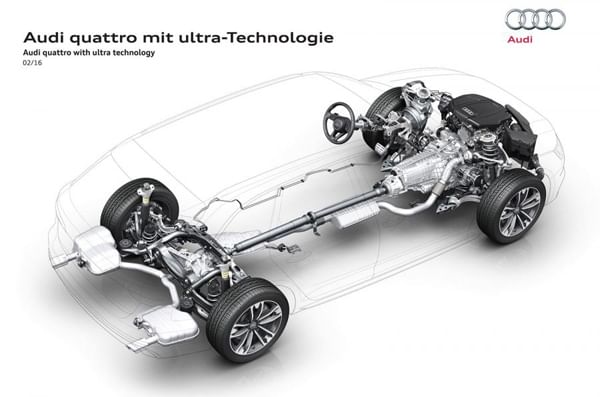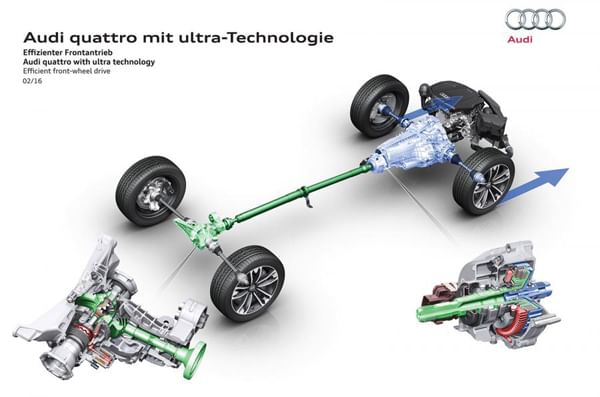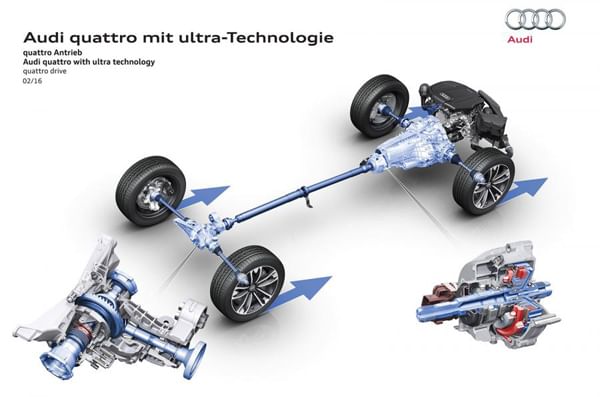Audi has unveiled a new version of its quattro four-wheel-drive system. The system uses an electro-mechanically operated multi-plate clutch and rear gear set to eliminate mechanical drag by completely cutting drive to the rear differential, and with it the rear wheels, when the driver only requires front-wheel drive.
To be marketed under the name 'quattro ultra', the new system abandons the widely used Torsen torque sensing system, as well as the central differential and rear differential hardware used by Audi, in one form or the other, since the inception of its original quattro four-wheel-drive system back in 1980.
In its place is a fully networked setup capable of analysing driving conditions every 100 milliseconds and automatically providing either front- or four-wheel drive, depending on factors such as longitudinal acceleration, engine torque, steering angle, yaw rate, prevailing traction and driving style.
Set to make its debut in the upcoming A4 Allroad, prior to being fitted to the new A5 coupé and second-generation Q5, the contemporary new quattro ultra system will initially be offered on models based on Audi’s MLB platform in combination with its new high-compression turbocharged 2.0-litre four-cylinder petrol engine and seven-speed S-tronic dual clutch gearbox.
Unlike the old mechanical Torsen-based quattro system, which based its operation principally around existing traction levels, the new system is influenced by a wider range of information obtained from various sensors, as well as data relating to the road provided by the navigation system.

By combining this information, Audi says its new system can provide predictive operation by sensing whether the driver requires front- or four-wheel drive and adapting the apportioning of drive to suit. In doing so, the new system is able to run in a more efficient state than the Torsen arrangement, which will continue to be used on more powerful Audi models, including upcoming RS models from the German carmaker’s Quattro division.
Mechanical developments on the quattro four-wheel-drive system are similar to those used on the four-wheel-drive versions of Audi’s transverse engine models, including the A1, A3, Q3 and TT.
It includes a new electro-mechanically operated multi-plate clutch mounted at the end of Audi’s seven-speed S-Tronic dual clutch gearbox. Depending on the model, it consists of between five and seven pairs of clutch plates that rotate in an oil bath. When the plates are pressed together, four-wheel drive is activated. The contact pressure between each plate is used to distribute drive between the front and rear axles.
The front multi plate clutch works in combination with a newly developed dog gear style rear differential featuring a decoupler operated via a so-called claw clutch. When the decoupler is closed, the prop shaft and differential are operated to provide drive to the rear wheels and thus provide four-wheel drive.
When running in front-wheel drive, the front multi-plate clutch disconnects the prop shaft. At the same time, a decoupling device within the rear differential opens to reduce friction and associated drag losses.

Unlike the process used by the existing Torsen system, the only rear-wheel drive components engaged when running in front wheel drive are the bevel gears within the axle and gears within the differential – the latter of which compensate for differences in the speed of rotation of the wheels during cornering.
A passive torque vectoring effect is provided to the rear wheels via selective braking activated by sensors in the ABS anti-lock brake and ESC (electric stability control) systems.
To activate four-wheel drive, the multi-plate clutch closes to operate the prop shaft. In doing so, it accelerates the gears in the rear differential. When they are running at a necessary speed, the claw clutch closes via pretensioned springs to provide drive to the rear wheels, at point which an electromagnetically actuated pin disengages a locking lever.

The quattro ultra system is claimed to weigh 4kg lesser than the existing Torsen-based quattro system.
When running in front-wheel drive, the front multi-plate clutch disconnects the prop shaft. At the same time, a decoupling device within the rear differential opens to reduce friction and associated drag losses.
Unlike the process used by the existing Torsen system, the only rear-wheel drive components engaged when running in front wheel drive are the bevel gears within the axle and gears within the differential – the latter of which compensate for differences in the speed of rotation of the wheels during cornering.
A passive torque vectoring effect is provided to the rear wheels via selective braking activated by sensors in the ABS anti-lock brake and ESC (electric stability control) systems.
To activate four-wheel drive, the multi-plate clutch closes to operate the prop shaft. In doing so, it accelerates the gears in the rear differential. When they are running at a necessary speed, the claw clutch closes via pretensioned springs to provide drive to the rear wheels, at point which an electromagnetically actuated pin disengages a locking lever.
The quattro ultra system is claimed to weigh 4kg lesser than the existing Torsen-based quattro system.
Also Read:






Comments
Member Login
Personal Details
No comments yet. Be the first to comment.